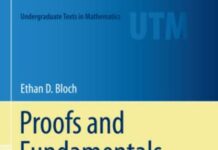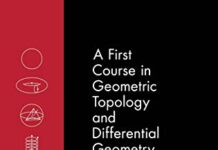
Ebook Info
- Published:
- Number of pages:
- Format: PDF
- File Size: 2.95 MB
- Authors: Ethan D. Bloch
Description
This text is a rigorous, detailed introduction to real analysis that presents the fundamentals with clear exposition and carefully written definitions, theorems, and proofs. It is organized in a distinctive, flexible way that would make it equally appropriate to undergraduate mathematics majors who want to continue in mathematics, and to future mathematics teachers who want to understand the theory behind calculus. The Real Numbers and Real Analysis will serve as an excellent one-semester text for undergraduates majoring in mathematics, and for students in mathematics education who want a thorough understanding of the theory behind the real number system and calculus.
User’s Reviews
Reviews from Amazon users which were colected at the time this book was published on the website:
⭐Pros:- Book is very rigorous- Proofs are written out fully in that there are practically no instances where the phrase ‘left to the reader’ entails anything more than a straightforward verification.- Due to the two points above, it’s a very easy read.Cons:- There are many errors (even beyond those in the books errata).- A lot of the proofs seem ad hoc. I realize that this is practically the case in every real analysis book, but I thought that it was even more pronounced in this book than in others.
⭐If all undergraduate math textbooks were written like this, a huge amount of frustration and difficulty would be spared from students. The author explicitly assumes that the reader has taken an undergraduate calculus course, but this book combines mathematical rigor with clarity in such a way that it is entirely feasible to read it without any prior exposure to mathematics beyond knowing how to read/write proofs.Side note: the latter skill is traditionally forced onto students by throwing them into the deep end (sometimes even in the form of a calculus course), but lately there has been a tendency to devise courses for this purpose (“introduction to mathematics” and the like, where one learns informal logic and is exposed to some essential mathematical structures). There are also a few books for this, such as Velleman’s How to Prove It. Incidentally, Bloch also published a book in that vein (
⭐), which I also think is among the best of its kind. Another good one with a more “hands-on actual math” approach is
⭐. My point is: if you are familiar with the rudiments in such books, you should be able to follow Bloch’s Analysis book painlessly.As a cursory glance at the contents will reveal, this is not a textbook in “Real Analysis” in the regular sense, i.e. advanced investigations into the reals. The material overlaps part of that in Apostol’s Calculus and Zorich’s Analysis, and broadly speaking, this book is in the same category as those two, but with significant differences in coverage: it is smaller, and so covers much less ground (Apostol also covers multivariate calculus and some linear algebra, Zorich also has more topics and more theorems within each topic). For example, complex numbers are not used in Bloch. On the other hand, the 1st chapter contains a rigorous foundational discussion of the reals, in which they are meticulously constructed from the naturals (starting with the Dedekind/Peano axioms).As mentioned in the introduction, the distinguishing feature of this book in terms of material is that sequences and series are left to the last chapters. Thus, limits, differentiation and integration are treated without them. As a result, the reader is given a clearer view of how the canonical results involving continuity follow from the least upper bound axiom (or its equivalent statements). For some, this would be considered a drawback, since some of the classical theorems have rather complicated proofs when sequences are not used. For me however, the distinguishing feature of this text is its lucidity and concision (yet it is as rigorous as they come!), as well as the goal-directed organization of material. The choice to omit a lot of commonly-included incidental material here is astute. Reading books like Zorich’s can be a bit overwhelming in that many side-routes are taken (sometimes for theorems that are very important in their own right), and the beginner may lose track of the larger logical structure over all these results. In Bloch, only the core material is discussed, and so every paragraph is to the point, and well motivated. Also, he avoids abstruse notation that is often found in Analysis texts.The exercises are not difficult, and so might disappoint somebody who is used to fancy ones (in the Russian tradition), or those that involve physics and real-world applications (as in Zorich). Also, there are relatively few, but they are well chosen. They are almost always of the “have you understood the above definitions and theorems” type, and usually do not require much imagination beyond that. These are not disadvantages in my opinion – everything in this book feels *to the point*.Moreover, there are historical sections that are very informative, and impressively long for such a textbook (though they are given at breakneck speed – the history of calculus cannot be compressed into a few pages otherwise.) To sum up, I found this book much clearer and easier to read than Apostol, Zorich, and “Baby Rudin” (the only books that I am familiar with that are more-or-less comparable). For readers struggling with such classic texts, and who are also interested in the extra material they contain, I would recommend starting with Bloch: secure the foundations and then move on.[edit 2014:] Another thing about this book that is worth mentioning is the relative lack of concrete examples (such as computation of integrals or series involving specific elementary functions). As the author assumes that reader has taken a calculus course, this is an understandable omission (the same is true for, say, “Baby Rudin”). However, for the reader who would like, from the outset, to study “calculus” with the rigor associated with “analysis” courses (i.e. the European/Russian, not the US, way), this book would not be ideal. The only such English analysis book I know of that matches Bloch’s level of rigor and user-friendliness, while also having many examples and exercises involving specific functions is
⭐. On the other hand, the foundational stuff (construction of the reals, etc.) is not treated there, and Bloch does it wonderfully.
⭐First of all I would just like to say that the point made by other reviewers regarding some of the proofs is completely valid, and it’s something I actually thought myself before even seeing the reviews for this book, but I thought removing a star for that reason would have been unfair and even unreasonable.To start with, the only reason I *know* I don’t like the proofs, is because Professor Bloch’s narrative and focus on developing the intuition behind every concept made me enjoy the process enough to keep working through the exercises in the book years after my real analysis class was over. His exposition on the historical developments of calculus and analysis was equally enjoyable, and it inspired to me to keep inquiring into the history of mathematics on my own.Ultimately, the true value of this book is that it me realize I was trying to learn, and it made me want to *understand*. Without this masterpiece Professor Bloch created, I truly believe I would not and could not have grown enough to be able to develop my own formulation for what constitutes a “good proof.” I will buy anything he puts his name on, grocery lists included.
⭐Ideal para aquellos lectores que busquen un libro de análisis matemático en el que se explique con todo detalle la construcción rigurosa de los sistemas numéricos a partir de los axiomas de Peano de los números naturales. Ethan Bloch desarrolla de una manera magistral los argumentos lógicos que conducen de los axiomas a los lemas, proposiciones o teoremas. Por ejemplo, su introducción de la integral de Riemann es realmente notable, asi como el tratamiento de las funciones transcendentes. Manual imprescindible para obtener una base realmente sólida del análisis real.Every proof in this book is rigorous,and on top of that this book is highly readable. Rigorous logic is crucial in proving mathematical theorems.
Keywords
Free Download The Real Numbers and Real Analysis 2011th Edition in PDF format
The Real Numbers and Real Analysis 2011th Edition PDF Free Download
Download The Real Numbers and Real Analysis 2011th Edition PDF Free
The Real Numbers and Real Analysis 2011th Edition PDF Free Download
Download The Real Numbers and Real Analysis 2011th Edition PDF
Free Download Ebook The Real Numbers and Real Analysis 2011th Edition

